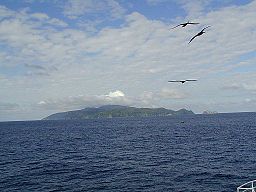The following post was written by Treasure Island Assistant Director and Dramaturg Rebecca Fredrickson.

The Island itself draws from multiple inspirations. While it is clearly meant to be located somewhere in the Caribbean, it has been argued that the island bears more resemblance to Monterey, which Stevenson was writing about around the same time. Descriptions of Treasure Island’s booming surf, pines and oaks, and sea lions do seem reminiscent of the California coast rather than the Caribbean.
Many critics and historians have also speculated that RLS’s writing of Treasure Island was influenced, at least in part, by the mythos surrounding an island called Cocos Island. Belonging to Costa Rica and located off the coast of Colombia, this island was well known as a pirate haven. It was isolated and away from commonly used (and surveilled) trade routes, but it was still easily accessible by ship. Therefore, it became a sort of landing for pirates hiding from pursuit.
According to legend, a massive treasure was loaded onto the ship Mary Dear for safekeeping during a siege of Lima, Peru in 1820. However, the Scottish Captain Thompson clearly couldn’t resist such a prize; the passengers, including the upper crust and clergy of Lima, were massacred and thrown overboard, and the treasure was, according to legend, buried on Cocos Island for safekeeping. Captain Thompson allegedly revealed the location of the treasure in the form of a map to a friend called Keating on his deathbed. This treasure is estimated to be worth up to $208 million.
Since this time, hundreds of treasure hunters have swarmed the island, digging it up in search of treasure. Several ‘authentic’ maps have surfaced over the years. These maps often have highly convoluted instructions similar to those on the map found by Jim Hawkins, and they have led to ultimately fruitless digs. One such unsuccessful dig took place in 1879, while RLS was in San Francisco waiting for Fanny’s divorce to finalize. The treasure hunters ended up sailing back to America empty-handed, and their return to San Francisco was well-documented in the local newspapers. It can therefore be surmised that RLS at least knew of Cocos Island and its legendary buried riches. This is further substantiated by the fact that he renamed his dog “Bogue”, which is the name of the master of the vessel Keating took on the original treasure hunt to Cocos Island.
Cocos Island and Treasure Island bear several similarities, the most obvious being their massive wealth in buried treasure (the treasure on Treasure Island, converted to today’s money, would be worth about $150 million). Both treasure maps were deathbed gifts to close friends. Both islands are also similarly unpleasant as described; Cocos Island is infested by rats and generally uninhabitable, while Jim’s descriptions of Treasure Island are anything but idyllic. Although Cocos Island is in the Pacific and Treasure Island is in the Atlantic, their similarities lead to the conclusion that Cocos Island was at least a spiritual ancestor to Treasure Island.
Our thrilling adaptation of Treasure Island runs Nov 22-Dec 24. Click here for more information and tickets.
Want to learn more? Check out these books!
Alex Capus. “Sailing by Starlight: In Search of Treasure Island”.
Ernest Mehew, editor. “Selected Letters of Robert Louis Stevenson”.
Children: Angelica Shirley Carpenter. “Robert Louis Stevenson: Finding Treasure Island”.